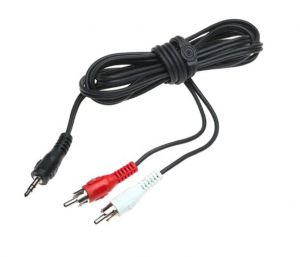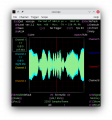Difference between revisions of "Software Oscilloscopes"
(moved and new text) |
|||
| Line 16: | Line 16: | ||
Note that a single chinch socket has to pins: One for ground, one for the signal. This puts it on equal footing with a BNC connector or a ''mono'' phone connector. The adapter shown on the right joins two outputs together to a ''stereo'' sound signal. | Note that a single chinch socket has to pins: One for ground, one for the signal. This puts it on equal footing with a BNC connector or a ''mono'' phone connector. The adapter shown on the right joins two outputs together to a ''stereo'' sound signal. | ||
| + | === List of software based oscilloscopes === | ||
| + | <gallery> | ||
| + | File:Webscope_Screenshot.png|link=Web Oscilloscope|[[Web Oscilloscope|Browser based oscilloscopes]] | ||
| + | File:Win Softscope 1.png|link=Win Soundcard Oscilloscope|[[Win Soundcard Oscilloscope]] | ||
| + | File:Xoscope_Screenshot.png|link=Xoscope|[[Xoscope]] linux desktop oscilloscope | ||
| + | </gallery> | ||
| − | + | [[Category:Software]] | |
| − | |||
| − | |||
| − | |||
| − | |||
| − | |||
| − | |||
| − | |||
| − | |||
| − | |||
| − | |||
| − | |||
| − | |||
| − | |||
| − | |||
| − | |||
| − | |||
| − | [[ | ||
Revision as of 14:58, 14 July 2021
What follows is a curated list of Software oscilloscopes (also abbreveated as Softscopes). While basically any modern digital storage oscillscope is formally a softscope, we want to discuss here only software running on commodity/consumer level hardware such as on
- Desktops and Laptops: Windows/Mac/Linux
- Mobile devices: tablets and smartphones
- Embedded: System on chips and microcontrollers, such as Raspberry Pi and Arduino
For data aquisition, several techniques exist:
- Soundcard input for mono or stereo audio recording
- ADCs on boards for analog to digital conversion, typically embedded within microcontrollers
Soundcard based input
In this case, the idea is that you connect your Analog Thing to your Soundcard input with a simple Chinch-to-jack adapter, such as depicted in the right. This allows to connect to the 3.5mm phone connector (German: Klinke) which is still present in many notebooks, tablets, smartphones, also for some single board systems (unfortunately not Raspberry Pi). If your system does not have such an input, you may use a USB adapter (often referred to as USB sound card). For a list of possible hardware, see the article about Soundcards.
Note that a single chinch socket has to pins: One for ground, one for the signal. This puts it on equal footing with a BNC connector or a mono phone connector. The adapter shown on the right joins two outputs together to a stereo sound signal.
List of software based oscilloscopes
Xoscope linux desktop oscilloscope



